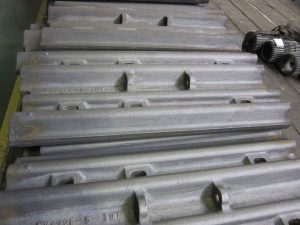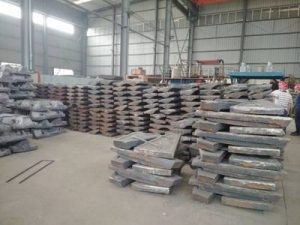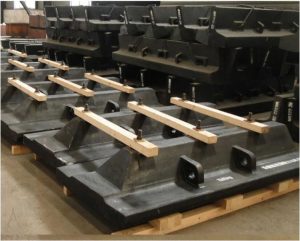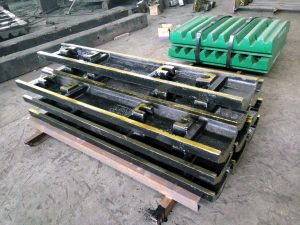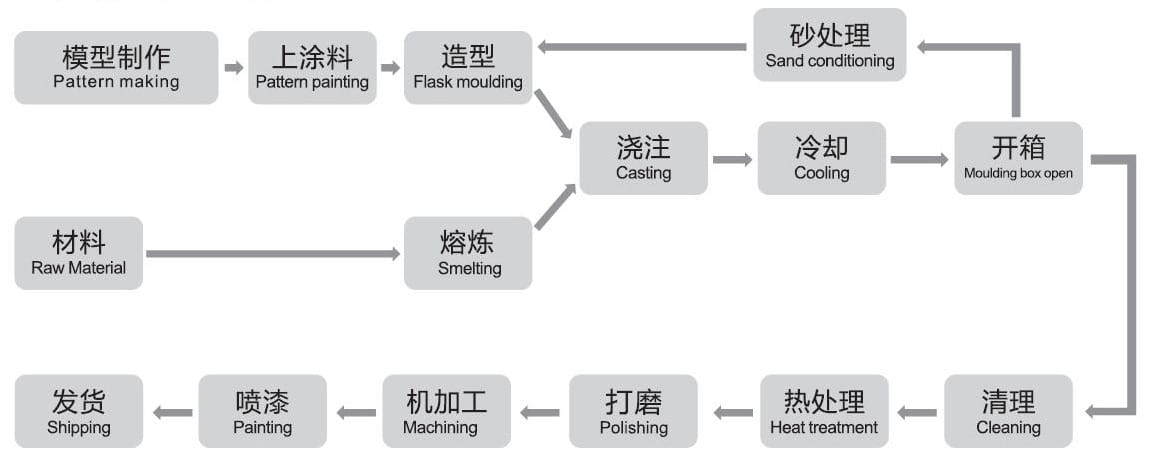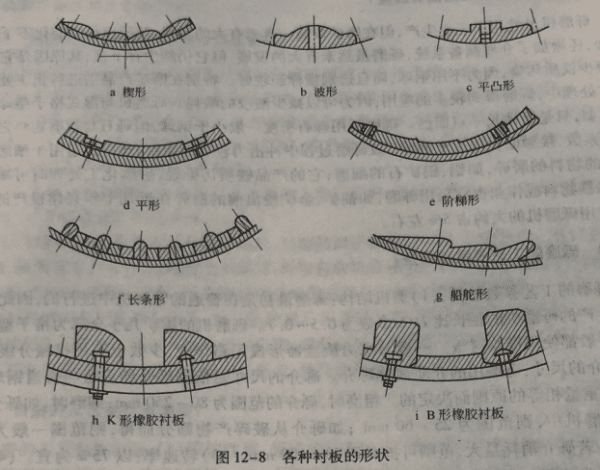Ball Mill Liner Material Selection
Different crushed material, different working conditions need different material liners to suit. Also, the coarse grinding compartment and fine grinding compartment need different material liners.
Qiming Machinery supplies the following material to cast your ball mill liner:
Manganese Steel
The manganese content of the high manganese steel ball mill lining plate is generally 11-14%, and the carbon content is generally 0.90-1.50%, most of which are above 1.0%. At low impact loads, the hardness can reach HB300-400. At high impact loads, the hardness can reach HB500-800. Depending on the impact load, the depth of the hardened layer can reach 10-20mm. The hardened layer with high hardness can resist impact and reduce abrasive wear. High manganese steel has excellent anti-wear performance under the condition of strong impact abrasive wear, so it is often used in wear-resistant parts of mining, construction materials, thermal power, and other mechanical equipment. Under the conditions of low impact conditions, high manganese steel cannot exert the characteristics of the material because the work hardening effect is not obvious.
Chemical Composition
| Name |
Chemical Composition(%) |
| C |
Si |
Mn |
Cr |
Mo |
Cu |
P |
S |
| Mn14 Mill Liner |
0.9-1.5 |
0.3-1.0 |
11-14 |
0-2.5 |
0-0.5 |
≤0.05 |
≤0.06 |
≤0.06 |
| Mn18 Mill Liner |
1.0-1.5 |
0.3-1.0 |
16-19 |
0-2.5 |
0-0.5 |
≤0.05 |
≤0.06 |
≤0.06 |
Mechanical properties and metallographic structure
| Name |
Surface Hardness(HB) |
Impact value Ak(J/cm2) |
Microstructure |
| Mn14 Mill Liner |
≤240 |
≥100 |
A+C |
| Mn18 Mill Liner |
≤260 |
≥150 |
A+C |
| C -Carbide | Carbide A-Retained austenite | Austenite |
Product specification
| Size |
Hole Dia.(mm) |
Liner Length(mm) |
| ≤40 |
≥40 |
≤250 |
≥250 |
| Tolerance |
+2
0 |
+3
0 |
+2 |
+3 |
Chrome Alloy Steel
Chromium alloy cast iron is divided into high chromium alloy cast iron (chromium content 8-26% carbon content 2.0-3.6%), medium chromium alloy cast iron (chromium content 4-6%, carbon content 2.0-3.2%), low chromium Three types of alloy cast iron (chromium content 1-3%, carbon content 2.1-3.6%). Its remarkable feature is that the microhardness of M7C3 eutectic carbide is HV1300-1800, which is distributed in the form of a broken network and isolated on the martensite (the hardest structure in the metal matrix) matrix, reducing the cleavage effect on the matrix. Therefore, the high-chromium alloy liner has high strength, ball mill toughness, and high wear resistance, and its performance represents the highest level of current metal wear-resistant materials.
Chemical Composition
| Name |
Chemical Composition(%) |
| C |
Si |
Mn |
Cr |
Mo |
Cu |
P |
S |
| High Chrome Alloy Liner |
2.0-3.6 |
0-1.0 |
0-2.0 |
8-26 |
≤3.0 |
≤1.2 |
≤0.06 |
≤0.06 |
| Middle Chrome Alloy Liner |
2.0-3.3 |
0-1.2 |
0-2.0 |
4-8 |
≤3.0 |
≤1.2 |
≤0.06 |
≤0.06 |
| Low Chrome Alloy Liner |
2.1-3.6 |
0-1.5 |
0-2.0 |
1-3 |
0-1.0 |
≤1.2 |
≤0.06 |
≤0.06 |
Mechanical properties and metallographic structure
| Name |
Surface(HRC) Ak(J/cm2) |
Microstructure |
| High Chrome Alloy Liner |
≥58 |
≥3.5 |
M+C+A |
| Middle Chrome Alloy Liner |
≥48 |
≥10 |
M+C |
| Low Chrome Alloy Liner |
≥45 |
≥15 |
M+C+P |
| M- Martensite |
C – Carbide |
A-Austenite |
P-Pearlite |
Product specification
| Size |
Hole Dia.(mm) Liner Length(mm) |
| ≤40 |
≥40 |
≤250 |
≥250 |
| Tolerance |
+2
0 |
+3
0 |
+2 |
+3 |
Cr-Mo Alloy Steel
Qiming Machinery uses Cr-Mo alloy steel to cast ball mill liner. This material based on Australia standard, (AS2074 Standard L2B, and AS2074 Standard L2C)it’s provides superior impact and wear resistance in all semi-autogenous milling applications.
Chemical Composition
Physical Property & Microstructure
Ni-hard Steel
Ni-Hard is a white cast iron, alloyed with nickel and chromium suitable for low impact, sliding abrasion for both wet and dry applications. Ni-Hard is an extremely wear-resistant material, cast in forms and shapes which are ideal for use in abrasive and wear environments and applications.
Chemical Composition
| Name |
C |
Si |
Mn |
Ni |
Cr |
S |
P |
Mo |
Hardness |
| Ni-Hard AS2027 Gr Ni Cr 1-550 |
3.2-3.6 |
0.3-0.8 |
0.2-0.8 |
3.0-5.0 |
1.5-3.0 |
≤0.12 |
≤0.15 |
≤0.5 |
550-600HBN |
| Ni-Hard AS2027 Gr Ni Cr 2-550 |
2.8-3.2 |
0.3-0.8 |
0.2-0.8 |
3.0-5.0 |
1.5-3.0 |
≤0.12 |
≤0.15 |
≤0.5 |
500-550HBN |
| Ni-Hard AS2027 Gr Ni Cr 2-550 |
3.2-3.6 |
1.5-2.2 |
0.2-0.8 |
4.0-5.5 |
8.0-10.0 |
≤0.12 |
≤0.15 |
≤0.5 |
630-670HBN |
White Iron Steel
White iron liner is recommended to be using at low impact working condition such as :
1. Belt conveyor liner for the Mining industry.
2. Cement plant ball mill.
3. Chemical industry ball mill.
Chemical Composition
Physical Property & Microstructure
If you have a special material inquiry, please contact our engineer to service you!

